Spatiotemporal Changes in Water Yield Function and Its Influencing Factors in the Tibetan Plateau in the Past 20 Years
Abstract
1. Introduction
2. Materials and Methods
2.1. Study Region
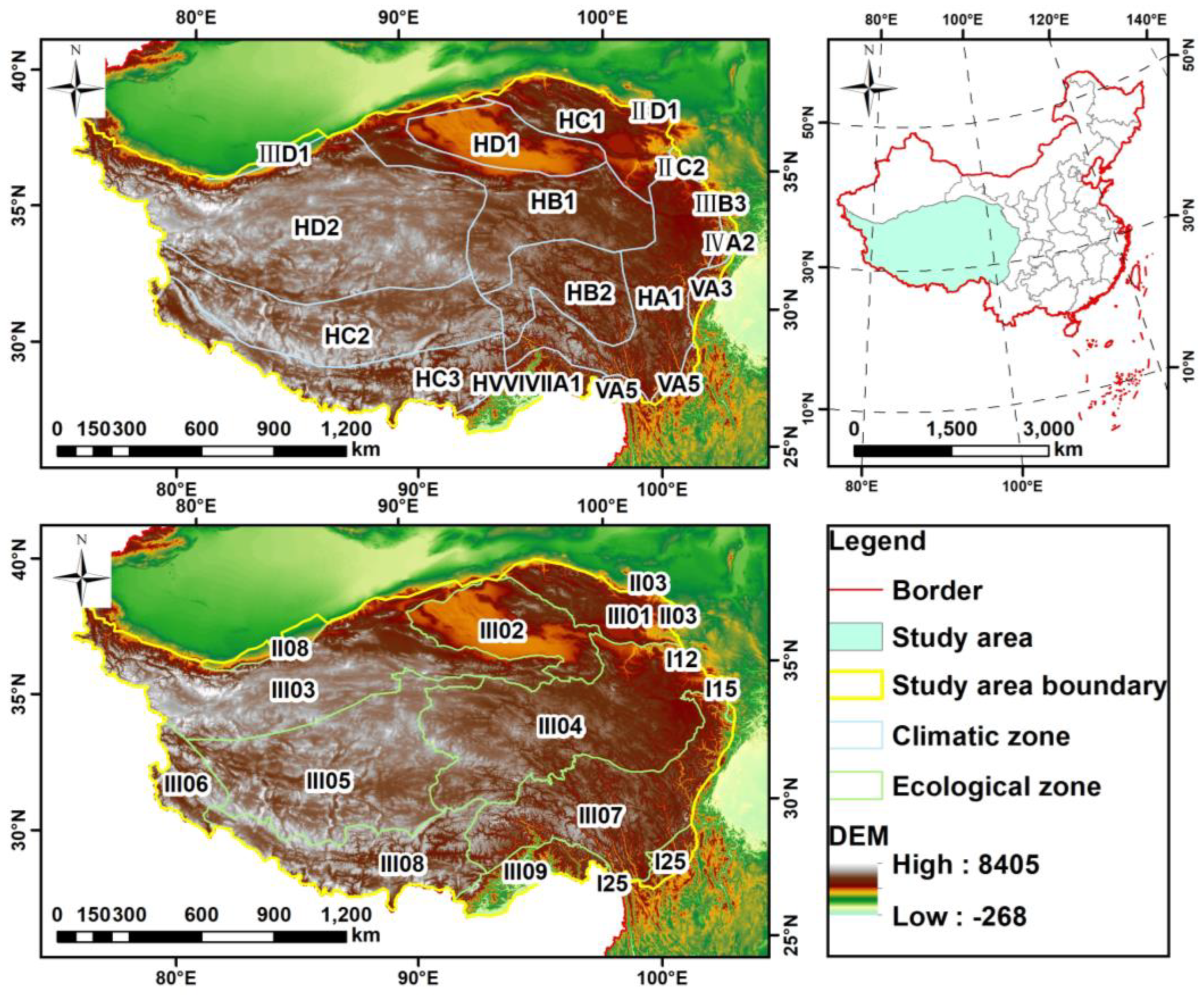
2.2. Data Sources and Data Processing
2.3. Methodology
3. Results
3.1. Water Yield Calculation Results and Verification
3.2. Temporal and Spatial Variation in Water Yield
4. Discussion
4.1. Analysis of Influencing Factors of Spatial Distribution Pattern
4.1.1. Spatial Distribution Pattern of Water Yield under Different Terrain Types
4.1.2. Spatial Distribution Patterns of Water Yield under Different Climatic Types
4.1.3. Spatial Distribution Patterns of Water Yield under Different Ecological Types
4.2. Analysis of Influencing Factors of Spatiotemporal Variation Characteristics
4.2.1. Analysis of the Influencing Factors of Climate Change on the Spatiotemporal Changes in Water Yield
4.2.2. Analysis of the Influencing Factors of Vegetation Change on the Spatiotemporal Changes in Water Yield
4.3. Uncertainty and Limitations
5. Conclusions
Author Contributions
Funding
Institutional Review Board Statement
Informed Consent Statement
Data Availability Statement
Acknowledgments
Conflicts of Interest
References
- Zheng, H.; Li, Y.; Ouyang, Z.; Luo, Y. Progress and perspectives of ecosystem services management. Acta Ecol. Sin. 2013, 33, 702–710. [Google Scholar] [CrossRef]
- Hu, W.; Li, G.; Gao, Z.; Ji, A.G.; Wang, Z.; Li, Y. Assessment of the impact of the Poplar Ecological Retreat Project on water conservation in the Dongting Lake wetland region using the InVEST model. Sci. Total Environ. 2020, 733, 139423. [Google Scholar] [CrossRef]
- Zhang, M.; Zhao, Y.; Liu, F.; Pan, X. Glacier Dynamics and Water Balance in the Qinghai-Tibet Plateau. Environ. Sci. Technol. 2012, 46, 6449–6450. [Google Scholar] [CrossRef]
- Wu, S.; Zhou, W.; Yan, K.; Zhang, X. Response of the Water Conservation Function to Vegetation Dynamics in the Qinghai-Tibetan Plateau Based on MODIS Products. IEEE J. Sel. Top. Appl. Earth Obs. Remote Sens. 2020, 13, 1675–1686. [Google Scholar] [CrossRef]
- Jia, Y.; Yang, Q.; Hu, F.; Ju, Q.; Wang, G. Prospect and progress of water conservation capacity evaluation in a changing environment. Hydro-Sci. Eng. 2022, 1, 37–47. [Google Scholar]
- Li, M.; Liang, D.; Xia, J.; Song, J.; Cheng, D.; Wu, J.; Cao, Y.; Sun, H.; Li, Q. Evaluation of water conservation function of Danjiang River Basin in Qinling Mountains, China based on InVEST model. J. Environ. Manag. 2021, 286, 112212. [Google Scholar] [CrossRef] [PubMed]
- Wang, Y.; Ye, A.; Peng, D.; Miao, C.; Di, Z.; Gong, W. Spatiotemporal variations in water conservation function of the Tibetan Plateau under climate change based on InVEST model. J. Hydrol. Reg. Stud. 2022, 41, 101064. [Google Scholar] [CrossRef]
- Zhang, X.; Li, Y.; Lv, C.; Bi, R.; Xia, L.; Guo, Y.; Wang, Y.; Xv, C.; Sun, B. Research progress on the application of ecosystem service functions based on the InVEST model. Ecol. Sci. 2022, 41, 237–242. [Google Scholar] [CrossRef]
- Wang, Y.; Xv, P.; Xv, B.; Wang, W.; Wang, H. Water Conservation Function Assessment Models of Forest cosystem:A Review. Ecol. Econ. 2018, 34, 158–164, 169. [Google Scholar]
- Govind, A.; Chen, J.M.; Margolis, H.; Ju, W.; Sonnentag, O.; Giasson, M.-A. A spatially explicit hydro-ecological modeling framework (BEPS-TerrainLab V2.0): Model description and test in a boreal ecosystem in Eastern North America. J. Hydrol. 2009, 367, 200–216. [Google Scholar] [CrossRef]
- Xie, X.; Li, A.; Jin, H.; Bian, J.; Zhang, Z.; Nan, X. Comparing Three Remotely Sensed Approaches for Simulating Gross Primary Productivity over Mountainous Watersheds: A Case Study in the Wanglang National Nature Reserve, China. Remote Sens. 2021, 13, 3567. [Google Scholar] [CrossRef]
- Zheng, X.; Chen, L.; Gong, W.; Yang, X.; Kang, Y. Evaluation of the Water Conservation Function of Different Forest Types in Northeastern China. Sustainability 2019, 11, 4075. [Google Scholar] [CrossRef]
- Peng, Z.; Li, Y.; Yu, W.; Xing, Y.; Feng, A.; Du, S. Study on the Applicability of Remote Sensing Precipitation Products in Different Climate Zones in China. J. Geo-Inf. Sci. 2021, 23, 3498–3507. [Google Scholar] [CrossRef]
- Li, Y.; Ma, X.; Qi, G.; Wu, Y. Studies on Water Retention Function of Anhui Province Based on InVEST Model of Parameter Localization. Resour. Environ. Yangtze Basin 2022, 31, 313–325. [Google Scholar]
- Nie, Y.; Gong, B.; Yi, X. Water Conservation Valuation of Qinghai-Tibet Plateau. Res. Soil Water Conserv. 2009, 16, 210–212. [Google Scholar]
- Long, D.; Li, X.; Li, X.; Han, P.; Zhao, F.; Hong, H.; Wang, Y.; Tian, F. Remote sensing retrieval of water storage hanges and underlying climatic echanisms over the Tibetan Plateau during 2000–2020. Adv. Water Sci. 2022, 33, 375–389. [Google Scholar]
- Yin, Y.; Wu, S.; Zhao, D.; Dai, E. The impact of climate change on water conservation in the source area of the Yellow River in the past 30 years. Geogr. Res. 2016, 35, 49–57. [Google Scholar]
- Zhang, J.; Liu, J.; Jin, J.; Ma, T.; Wang, G.; Liu, H.; Min, X.; Wang, H.; Lin, J.; Bao, Z.; et al. Evolution and Trend of Water Resources in Qinghai-Tibet Plateau. Bull. Chin. Acad. Sci. 2019, 34, 1264–1273. [Google Scholar]
- Nie, Y.; Gong, B.; Li, Z. Spatio-temporal variation of water conservation capacity in the Qinghai-Tibet Plateau. Earth Sci. Front. China Univ. Y Geosci. Beijing Peking Univ. 2010, 16, 373–377. [Google Scholar]
- Song, X.; Yan, C.; Xie, J.; Li, S. Assessment of changes in the area of the water conservation forest in the Qilian Mountains of China’s Gansu province, and the effects on water conservation. Environ. Earth Sci. 2012, 66, 2441–2448. [Google Scholar] [CrossRef]
- Niu, Y.; Li, S.; Liu, Y.; Shi, J.; Wang, Y.; Ma, Y.; Gao, L. Regulation of alpine meadow patch coverage on runoff and sediment under natural rainfall on the eastern Qinghai-Tibetan Plateau. J. Hydrol. 2021, 603, 127101. [Google Scholar] [CrossRef]
- Hua, T.; Wang, X. Temporal and Spatial Variations in the Climate Controls of Vegetation Dynamics on the Tibetan Plateau during 1982–2011. Adv. Atmos. Sci. 2018, 35, 1337–1346. [Google Scholar] [CrossRef]
- Taheri Dehkordi, A.; Valadan Zoej, M.J.; Ghasemi, H.; Ghaderpour, E.; Hassan, Q.K. A New Clustering Method to Generate Training Samples for Supervised Monitoring of Long-Term Water Surface Dynamics Using Landsat Data through Google Earth Engine. Sustainability 2022, 14, 8046. [Google Scholar] [CrossRef]
- Chen, B.; Zhang, X.; Tao, J.; Wu, J.; Wang, J.; Shi, P.; Zhang, Y.; Yu, C. The impact of climate change and anthropogenic activities on alpine grassland over the Qinghai-Tibet Plateau. Agric. For. Meteorol. 2014, 189–190, 11–18. [Google Scholar] [CrossRef]
- Pan, T.; Wu, S.; Liu, Y. Relative Contributions of Land Use and Climate Change to Water Supply Variations over Yellow River Source Area in Tibetan Plateau during the Past Three Decades. PLoS ONE 2015, 10, 373–377. [Google Scholar] [CrossRef] [PubMed]
- Yang, J.; Xie, B.; Zhang, D.; Tao, W. Climate and land use change impacts on water yield ecosystem service in the Yellow River Basin, China. Environ. Earth Sci. 2021, 80, 1–12. [Google Scholar] [CrossRef]
- Pan, T.; Wu, S.; Dai, E.; Liu, Y. Spatiotemporal variation of water source supply service in Three Rivers Source Area of China based on InVEST model. Chin. J. Appl. Ecol. 2013, 24, 183–189. [Google Scholar]
- Zhao, Y.; Zhou, J.; Lei, L.; Xiang, J.; Huang, M.; Feng, W.; Zhu, G.; Wei, W.; Wang, J. Identification of drivers for water yield in the upstream of Shiyang River based on InVEST model. Chin. J. Ecol. 2019, 38, 3789–3799. [Google Scholar]
- Liu, Y.; Li, Y.; Shan, S.; Yang, L.; Xu, H. Spatiotemporal variability in the water conservation amount in Gansu Qilian Mountain National Nature Reserve. Pratacultural Sci. 2021, 38, 1420–1431. [Google Scholar]
- Xue, J.; Li, Z.; Feng, Q.; Miao, C.; Deng, X.; Di, Z.; Ye, A.; Gong, W.; Zhang, B.; Gui, J.; et al. Spatiotemporal variation characteristics of water conservation amount in the Qilian Mountains from 1980 to 2017. J. Glaciol. Geocryol. 2022, 44, 1–13. [Google Scholar]
- Bao, Y.; Li, T.; Liu, H.; Ma, T.; Wang, H.; Liu, K.; Shen, Q.; Liu, X. Spatial-temporal variation of water conservation function in the Loess Plateau of northern Shaanxi based on InVEST model. Geogr. Res. 2016, 35, 664–676. [Google Scholar] [CrossRef]
- Xie, Y.; Gong, J.; Qi, S.; Wu, J.; Hu, B. Spatial-temporal differentiation of water supply services in Bailongjiang River Basin based on InVEST model. J. Nat. Resour. 2017, 32, 1337–1347. [Google Scholar] [CrossRef]
- Liu, J.; Fu, B.; Zhang, C.; Hu, Z.; Wang, Y. Water conservation capacity and value assessment of upper Min River ecosystem based on InVEST model. Resour. Environ. Yangtze Basin 2019, 28, 577–585. [Google Scholar]
- Wang, G.; Han, D. Analysis of water production function in the upper reaches of Daling River based on InVEST model. Yellow Rive R. 2020, 42, 42–47. [Google Scholar]
- Jia, W.; Wu, S.; Chen, A. Evaluation of ecosystem service functions in Chishui River Basin based on InVEST model. J. China Inst. Water Resour. Hydropower Res. 2020, 18, 313–320. [Google Scholar] [CrossRef]
- Deng, R.; Shai, H.; Huang, B.; Zhang, C.; Zhou, Z.; Fan, J. Remote evaluation of ecosystem integrity and time sequence study of national park group construction on the Qinghai-Tibet Plateau. Acta Ecol. Sin. 2021, 41, 847–860. [Google Scholar]
- Dai, E.; Wang, Y. Spatial heterogeneity and attribution analysis of water production services in Hengduan Mountain. Acta Geogr. Sin. 2020, 75, 607–619. [Google Scholar] [CrossRef]
- Di, Y.; Zhang, Y.; Zeng, H.; Tang, Z. Effects of Changed Asian Water Tower on Tibetan Plateau Ecosystem: A Review. Bull. Chin. Acad. Sci. 2019, 34, 1322–1331. [Google Scholar]
- Xu, X.; Chen, H.; Levy, J.K. K Spatial-temporal variation of vegetation cover characteristics of Qinghai-Tibet Plateau under climate warming and analysis of its causes. Sci. China Press 2008, 53, 456–462. [Google Scholar]
- Sirigu, S.; Montaldo, N. Climate Change Impacts on the Water Resources and Vegetation Dynamics of a Forested Sardinian Basin through a Distributed Ecohydrological Model. Water 2022, 14, 3078. [Google Scholar] [CrossRef]
- Zhao, S.; Fan, W.; Yu, N. Analysis of annual precipitation of Dong Zhiyuan based on wavelet and MK test. J. Hebei Univ. Eng. (Nat. Sci. Ed.) 2020, 27, 285–301. [Google Scholar]
- Wang, X.; Ma, M.; Song, Y.; Tan, J.; Wang, H. Coupling of a biogeochemical model with a simultaneous heat and water model and its evaluation at an alpine meadow site. Environ. Earth Sci. 2014, 72, 4085–4096. [Google Scholar] [CrossRef]
- Fu, B.; Ouyang, Z.; Shi, P.; Fan, J.; Wang, X.; Zheng, H.; Zhao, W.; Wu, F. Status of ecological security barrier and protection countermeasures on the Qinghai-Tibet Plateau. Policy Manag. Res. 2021, 36, 1298–1306. [Google Scholar] [CrossRef]
- Gao, Q.; Miao, Y.; Song, J. Research progress on sustainable development of the Qinghai-Tibet Plateau. Geogr. Res. 2021, 4, 1–17. [Google Scholar] [CrossRef]
- Dorje, L.L. Protection and utilization of water resources on the Qinghai-Tibet Plateau. Resour. Sci. 2005, 27, 23–27. [Google Scholar]
- Lan, X.; Ye, C.; Wang, Y.; Zeng, T.; Sun, J. Spatio-temporal evolution characteristics and driving force analysis of water conservation function on the Tibetan Plateau from 1995 to 2014. Acta Agrestia Sin. 2021, 29, 80–92. [Google Scholar]
- Liu, J.; Lang, X.; Su, J.; Liu, W.; Liu, H.; Tian, Y. Evaluation of water conservation function in the dry-hot valley area of Jinsha River Basin based on InVEST model. Acta Ecol. Sin. 2021, 41, 8099–8111. [Google Scholar]
- Zhou, W.; Liu, G.; Pan, J. Empirical estimation of effective soil water content: A case study of Northeast Black Soil. J. Arid Land Resour. Environ. 2003, 17, 88–95. [Google Scholar]
- Zhao, L.; Hu, G.; Zou, D.; Wu, X.; Ma, L.; Sun, Z.; Yuan, L.; Zhou, H.; Liu, S. Effects of Permafrost Changes on the Qinghai-Tibet Plateau on Hydrological Processes. Change Asian Water Tower 2019, 34, 1233–1246. [Google Scholar] [CrossRef]
- Liljedahl, A.K.; Boike, J.; Daanen, R.P.; Fedorov, A.N.; Frost, G.V.; Grosse, G.; Hinzman, L.D.; Iijma, Y.; Jorgenson, J.C.; Matveyeva, N.; et al. Pan-Arctic ice-wedge degradation in warming permafrost and its influence on tundra hydrology. Nat. Geosci. 2016, 9, 312–318. [Google Scholar] [CrossRef]
- Wu, P.; Liang, S.; Wang, X.-S.; McKenzie, J.M.; Feng, Y. Climate Change Impacts on Cold Season Runoff in the Headwaters of the Yellow River Considering Frozen Ground Degradation. Water 2020, 12, 602. [Google Scholar] [CrossRef]
- Liu, Z.; Li, S.; Wei, W.; Song, X. Research progress on wetland changes and driving forces on the Qinghai-Tibet Plateau in the past three decades. Chin. J. Ecol. 2019, 38, 856–862. [Google Scholar]
- Duan, H.; Xue, X.; Wang, T.; Kang, W.; Liao, J.; Liu, S. Spatial and Temporal Differences in Alpine Meadow, Alpine Steppe and All Vegetation of the Qinghai-Tibetan Plateau and Their Responses to Climate Change. Remote Sens. 2021, 13, 669. [Google Scholar] [CrossRef]
- Shi, W.; Qiao, F.; Zhou, L. Identification of Ecological Risk Zoning on Qinghai-Tibet Plateau from the Perspective of Ecosystem Service Supply and Demand. Sustainability 2021, 13, 5366. [Google Scholar] [CrossRef]
- Liu, X.; Chen, Y.; Li, Z.; Li, Y.; Zhang, Q.; Zan, M. Driving Forces of the Changes in Vegetation Phenology in the Qinghai-Tibet Plateau. Remote Sens. 2021, 13, 4952. [Google Scholar] [CrossRef]
- Chen, H.; Ouyang, W.; Lv, F.; Song, Y.; Hao, R. Variation of Vegetation Cover and Its Correlation of Topographic Factors in Guandu River Basin. Res. Soil Water Conserv. 2019, 26, 135. [Google Scholar]
- Ghaderpour, E.; Mazzanti, P.; Mugnozza, G.S.; Bozzano, F. Coherency and phase delay analyses between land cover and climate across Italy via the least-squares wavelet software. Int. J. Appl. Earth Obs. Geoinf. 2023, 118, 103241. [Google Scholar] [CrossRef]
- Liu, J.; Ji, Y.; Zhou, G.; Zhou, L.; Lyu, X.; Zhou, M. Temporal and spatial variations of net primary productivity (NPP) and its climate driving effect in the Qinghai-Tibet Plateau, China from 2000 to 2020. Chin. J. Appl. Ecol. 2022, 33, 1533–1538. [Google Scholar] [CrossRef]
- Xv, Y.; Huang, W.; Dou, S.; Guo, Z.; Li, X.; Zheng, Z.; Jing, J. Responding Mechanism of Vegetation Cover to Climate Change and Human Activities in Southwest China from 2000 to 2020. Environ. Sci. 2022, 43, 3230–3240. [Google Scholar] [CrossRef]
- Zhang, X.; Lu, L.; Yu, H.; Zhang, X.; Li, D. Multi-scenario simulation of the impact of land use change on the value of ecosystem services on the Qinghai-Tibet Plateau. Chin. J. Ecol. 2021, 40, 992. [Google Scholar]
- Gao, Y.; Huang, J.; Li, S.; Li, S. Spatial pattern of non-stationarity and scale-dependent relationships between NDVI and climatic factors—A case study in Qinghai-Tibet Plateau, China. Ecol. Indic. 2012, 20, 170–176. [Google Scholar] [CrossRef]
- Wang, H.; Qi, Y.; Huang, C.; Li, X.; Deng, X.; Zhang, J. Analysis of vegetation changes and dominant factors on the Qinghai-Tibet Plateau, China. Sci. Cold Arid Reg. 2019, 11, 150–158. [Google Scholar] [CrossRef]
- Chen, C.; Li, T.; Sivakumar, B.; Sharma, A.; Albertson, J.D.; Zhang, L.; Wang, G. Combined Effects of Warming and Grazing on Rangeland Vegetation on the Qinghai-Tibet Plateau. Front. Environ. Sci. 2021, 9, 797971. [Google Scholar] [CrossRef]
- Sun, L.; Li, H.; Wang, J.; Chen, Y.; Xiong, N.; Wang, Z.; Wang, J.; Xu, J. Impacts of Climate Change and Human Activities on NDVI in the Qinghai-Tibet Plateau. Remote Sens. 2023, 15, 587. [Google Scholar] [CrossRef]
- Cao, Y.; Sun, M.; Chen, M.; He, Y.; Song, H. Effects of precipitation on vegetation cover in the northern Tibetan Plateau from 2000 to 2016. Acta Ecol. Sin. 2022, 30, 721–730. [Google Scholar]
- Wang, L.; Wei, X.; Zhang, Z.; Guo, Z.; Huang, S. Changes of vegetation index in Qinghai-Tibet Plateau and its relationship with temperature and humidity factors. J. For. Environ. 2022, 42, 141–148. [Google Scholar]
- Guo, X.; Song, H.; Zhai, L. Spatial-temporal variation characteristics of vegetation cover on the Qinghai-Tibet Plateau and its driving factors. Chin. J. Ecol. 2022, 1–13. Available online: http://kns.cnki.net/kcms/detail/21.1148.Q.20221228.1533.009.html (accessed on 1 April 2023).
- Ouyang, X.; Dong, X.; Wei, R.; Gong, C.; Wu, H. Spatial-temporal variation of NDVI in vegetation growing season on the Qinghai-Tibet Plateau and its response to climatic factors. Res. Soiland Water Conserv. 2023, 30, 220–229. [Google Scholar] [CrossRef]
- Li, W.; Xv, J.; Yao, Y.; Zhang, Z. Temporal and spatial variation characteristics of vegetation index (NDVI) in the Sanjiangyuan area of the Qinghai-Tibet Plateau under the background of global warming. Mt. Res. 2021, 39, 473–482. [Google Scholar]
- Cai, L.; Tian, L.; Ao, Y.; Wang, X. Influence of human disturbance on vegetation cover change on the Qinghai-Tibet Plateau. Res. Soil Water Conserv. 2021, 28, 382–388. [Google Scholar] [CrossRef]
- Kumari, N.; Saco, P.M.; Rodriguez, J.F.; Johnstone, S.A.; Srivastava, A.; Chun, K.P.; Yetemen, O. The Grass Is Not Always Greener on the Other Side: Seasonal Reversal of Vegetation Greenness in Aspect—Driven Semiarid Ecosystems. Geophys. Res. Lett. 2020, 47, e2020GL088918. [Google Scholar] [CrossRef]
- Matsushita, B.; Yang, W.; Chen, J.; Onda, Y.; Qiu, G. Sensitivity of the Enhanced Vegetation Index (EVI) and Normalized Difference Vegetation Index (NDVI) to Topographic Effects: A Case Study in High-density Cypress Forest. Sensors 2007, 7, 2636–2651. [Google Scholar] [CrossRef] [PubMed]
- Yang, X.; Zuo, X.; Xie, W.; Li, Y.; Guo, S.; Zhang, H. A Correction Method of NDVI Topographic Shadow Effect for Rugged Terrain. IEEE J. Sel. Top. Appl. Earth Obs. Remote Sens. 2022, 15, 8456–8472. [Google Scholar] [CrossRef]
- Xiao, X.; Qiu, X.; Xv, J. Characteristics of wet and dry climate change in China from 1960 to 2019 based on the TerraClimate dataset. J. Chang. River Sci. Res. Inst. 2023, 40, 27–33. [Google Scholar]
- Abatzoglou, J.T.; Dobrowski, S.Z.; Parks, S.A.; Hegewisch, K.C. TerraClimate, a high-resolution global dataset of monthly climate and climatic water balance from 1958–2015. Sci Data 2018, 5, 170191. [Google Scholar] [CrossRef] [PubMed]
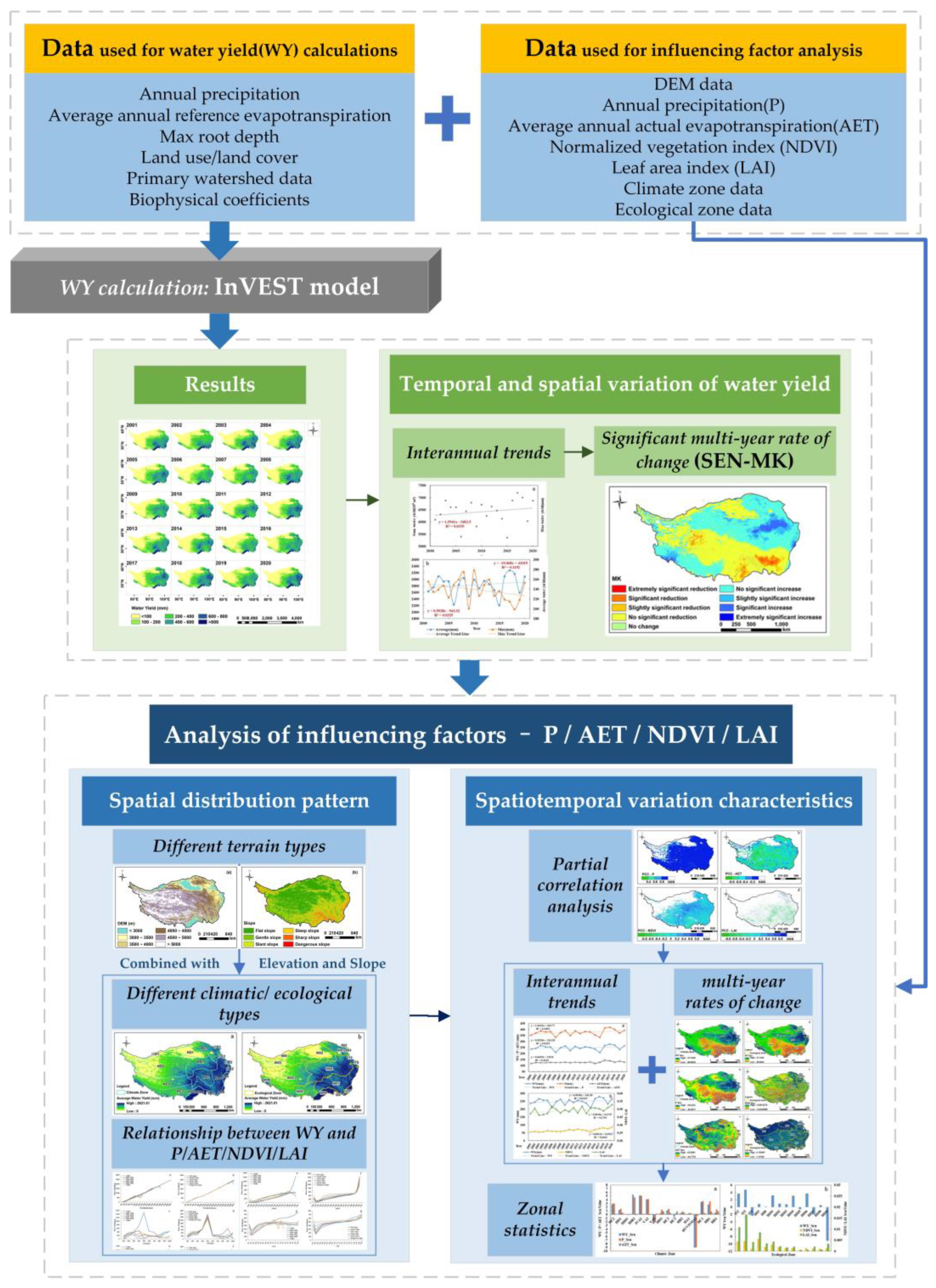
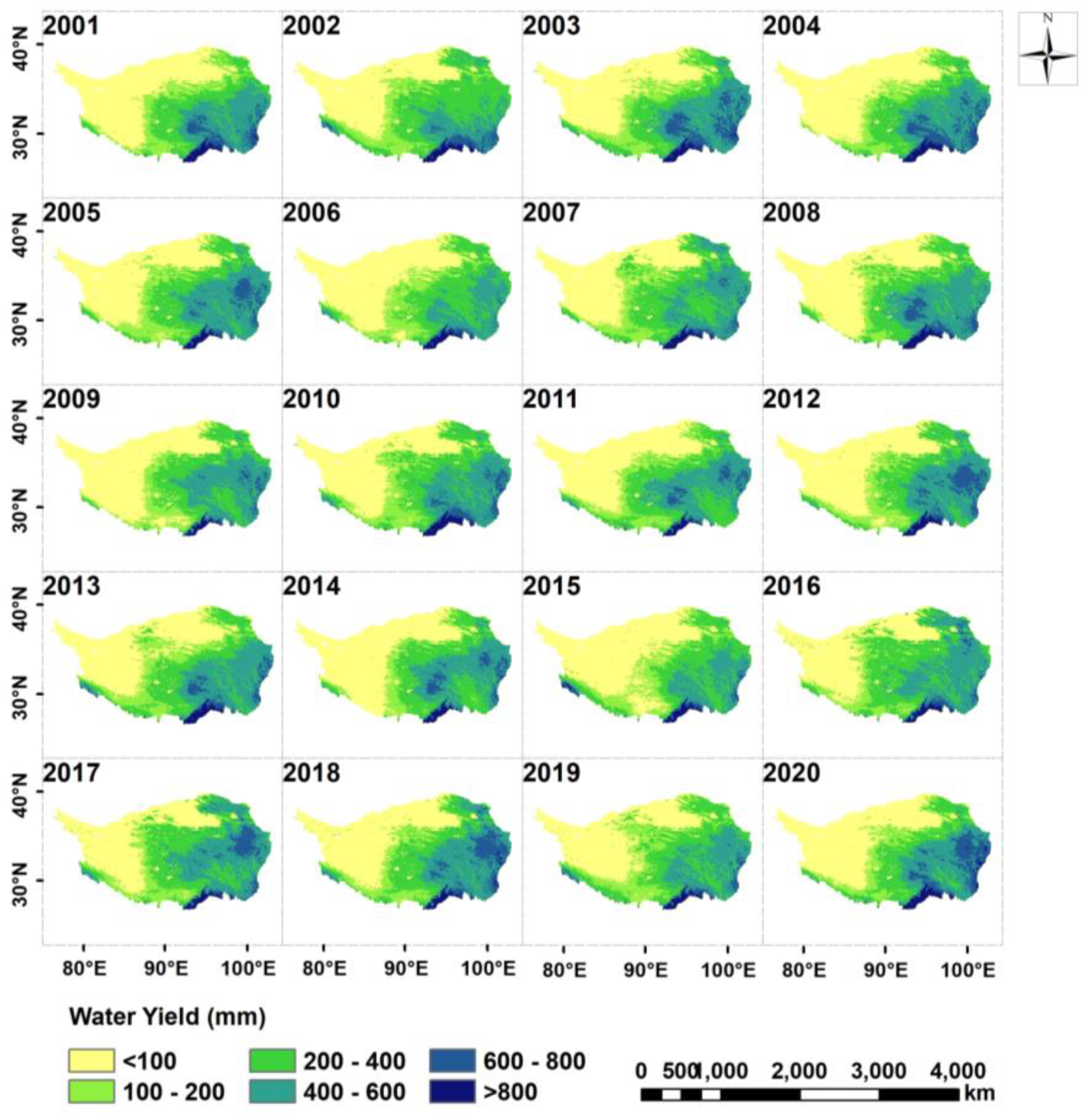



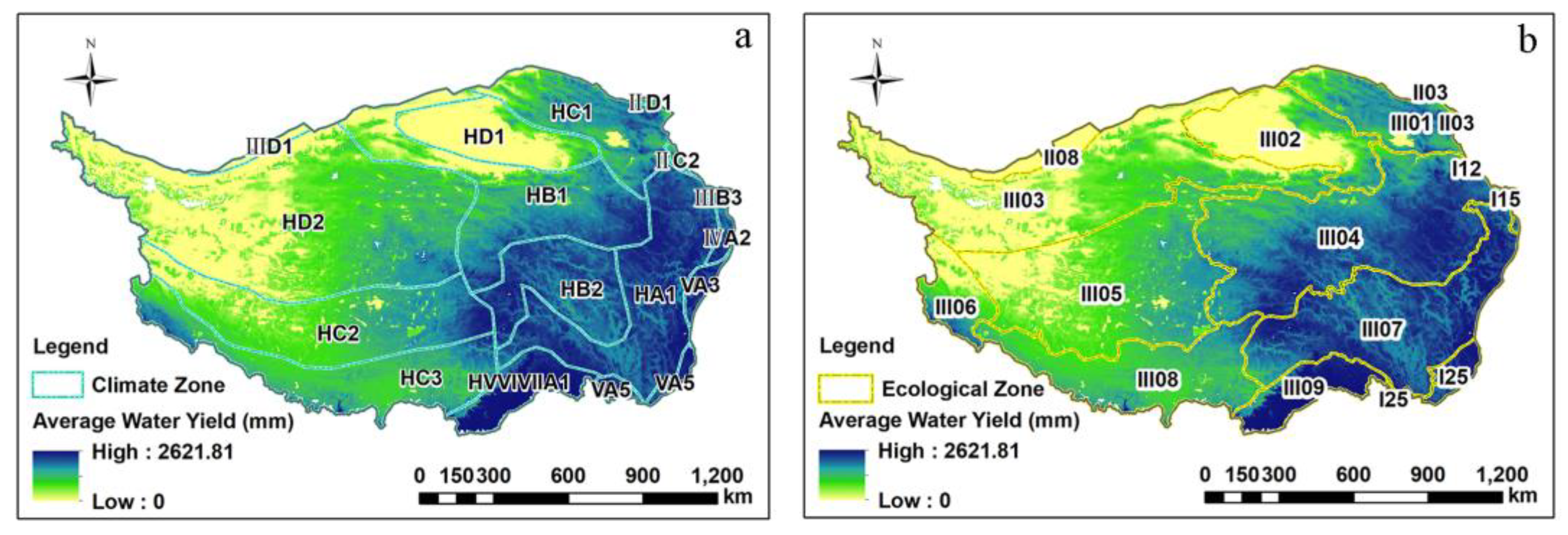

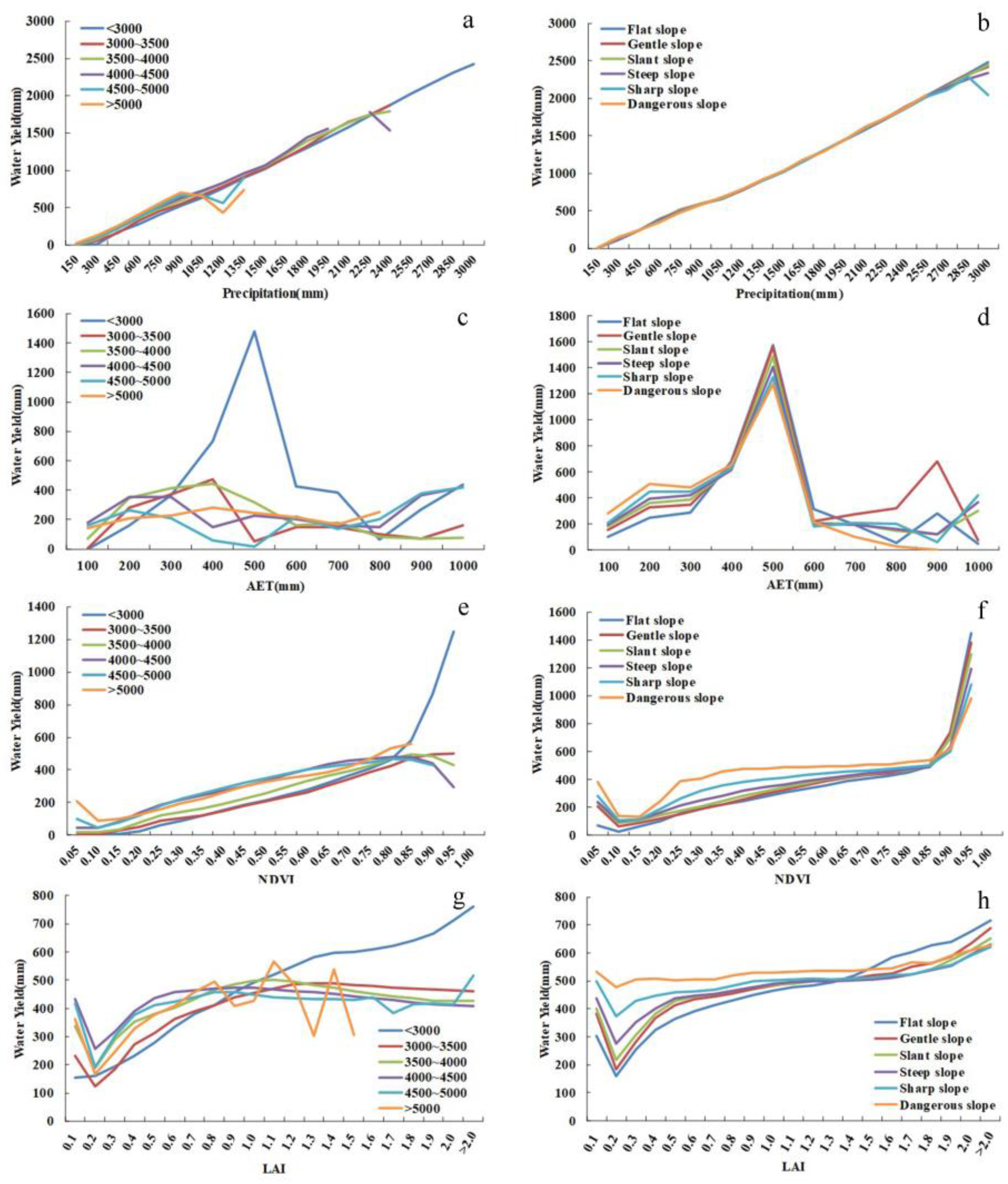
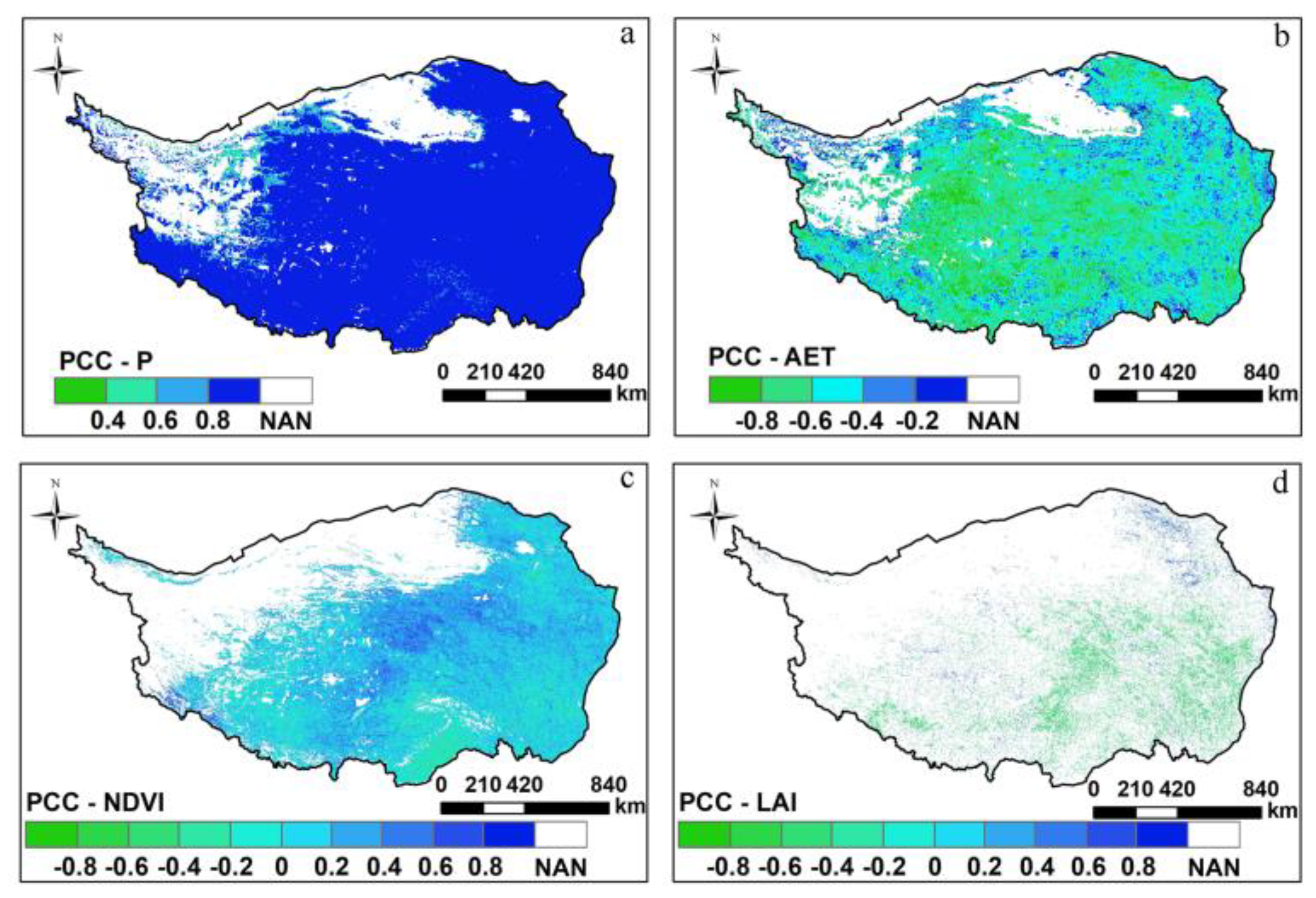

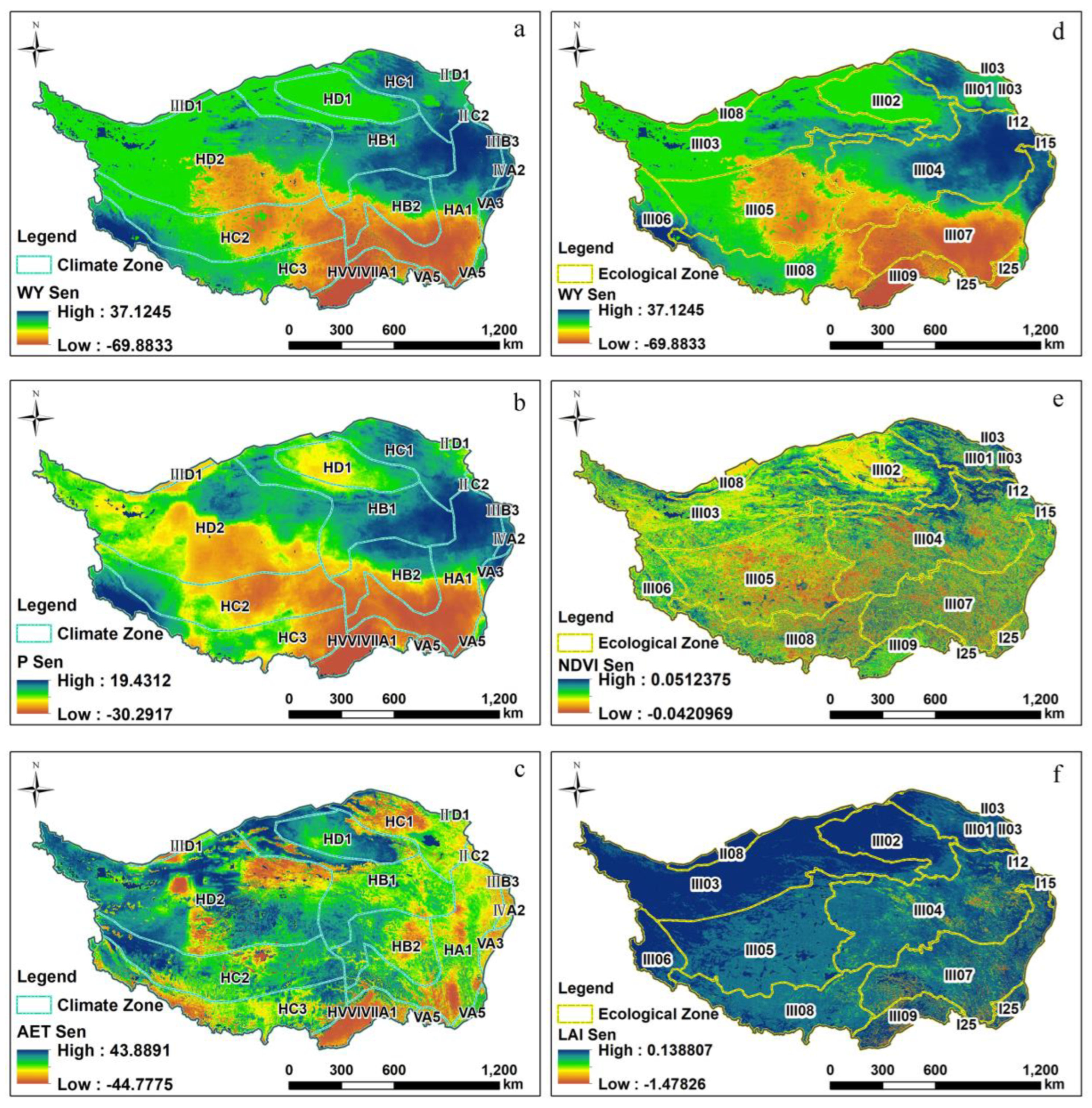

| First-Level Zone Code | First-Level Climate Zone | Second-Level Zone Code | Second-Level Climate Zone |
|---|---|---|---|
| II | Middle Temperate Zone | IIC2 | Central Mongolia |
| IID1 | Menggan | ||
| III | South Temperate Zone | IIID1 | Nanjiang |
| IIIB3 | Weihe | ||
| IV | North Subtropical Zone | IVA2 | Qinba |
| V | Middle Subtropical Zone | VA3 | Sichuan |
| VA5 | Northern Yunnan | ||
| H | Plateau Climate Zone | HD2 | Northern Tibet |
| HC3 | Southern Tibet | ||
| HC2 | Central Tibet | ||
| HB2 | Changdu | ||
| HA1 | Bomi–Western Sichuan | ||
| HVVIVIIA1 | Dawang–Chayu | ||
| HC1 | Qilian–Qinghai Lake | ||
| HB1 | Southern Qinghai | ||
| HD1 | Qaidam |
| Code | Ecological Zone |
|---|---|
| I12 | Agricultural and grassland ecological area of the Loess Plateau |
| I15 | Ecological area of deciduous and evergreen broad-leaved forest in Qinba Mountains |
| I25 | Ecological area of evergreen broad-leaved forest in Southwest Sichuan and North Central Yunnan |
| II03 | Grassland desertification ecological area in the middle of Inner Mongolia Plateau |
| II08 | Tarim Basin–Eastern Xinjiang desert ecological area |
| III01 | Qilian Mountain forest and alpine grassland ecological area |
| III02 | Desert ecological area of Qaidam Basin |
| III03 | Pamir–Kunlun–Altun alpine desert grassland ecological area |
| III04 | River source area–Gannan alpine meadow grassland ecological area |
| III05 | Alpine desert grassland ecological area of northern Tibetan Plateau |
| III06 | Ali Mountain warm arid desert ecological area |
| III07 | Cold temperate coniferous forest ecological area in Eastern Tibet–Western Sichuan |
| III08 | Alpine meadow grassland ecological area in Southern Tibet |
| III09 | Seasonal rainforest ecological area of tropical rain forest in Southeast Tibet |
| Data Name | Date Source | Spatial Resolution | Data Description |
|---|---|---|---|
| Annual precipitation | Monthly climate and climate–water balance datasets on the global land surface, TerraClimate (https://www.nature.com/, accessed on 1 April 2023) | 5 km × 5 km | Has relatively fine spatial resolution to fill gaps in climate data. |
| Average annual reference evapotranspiration | Monthly climate and climate–water balance datasets on the global land surface, TerraClimate (https://www.nature.com/, accessed on 1 April 2023) | 5 km × 5 km | On the basis of the data, the water balance model is used to derive the monthly surface water balance dataset. |
| Average annual actual evapotranspiration | InVEST model | 500 m × 500 m | Derived from the calculation results of the InVEST model water production module. |
| DEM data | Resources and Environmental Sciences and Data Center, Chinese Academy of Sciences (https://www.resdc.cn/, accessed on 1 April 2023) | 500 m × 500 m | Radar topographic mapping SRTM derived from the U.S. Space Shuttle Endeavour. |
| Max root depth | Soil dataset of China at the World World Soil Database (HWSD) (v1.1) (2009) (http://poles.tpdc.ac.cn/, accessed on 1 April 2023) | It contains detailed data such as maximum soil root depth (mm), clay content (%), powder content (%), sand content (%), organic matter content (%), soil bulk density (g/cm3), and so on. | |
| Land use/land cover (LULC) | Terrestrial Process Distributed Activity Archiving Center (LP DAAC) MOD12Q1 (https://lpdaac.usgs.gov/, accessed on 1 April 2023) | 500 m × 500 m | It was obtained by supervising classification processing by MODIS Terra and water reflectivity data, combining prior knowledge and supporting information. |
| NDVI | Terrestrial Process Distributed Activity Archiving Cente (LP DAAC) MOD13A1 v006 (https://lpdaac.usgs.gov/, accessed on 1 April 2023) | 500 m × 500 m | Contains enhanced vegetation index (EVI), which improves sensitivity to areas of high biomass. |
| LAI | Terrestrial Process Distributed Activity Archiving Cente (LP DAAC) MOD15A2H v006 (https://lpdaac.usgs.gov/, accessed on 1 April 2023) | 500 m × 500 m | A composite dataset of 8 days, combining LAI and photosynthetic effective radiation fraction (FPAR) products. |
| Primary watershed data | Resources and Environmental Sciences and Data Center, Chinese Academy of Sciences (https://www.resdc.cn/, accessed on 1 April 2023) | (Vector data) | It includes all river networks in the country and all sub-basins with an area greater than 100 km2. |
| Biophysical coefficients | Refer to the existing literature [46] | Includes the type coefficient, maximum root depth, and evapotranspiration coefficient Kc for each type of land use type. | |
| Zhang parameter (Z) | Refer to the existing literature [46] | (Empirical onstant) | It is a seasonal factor that can capture precipitation patterns and other hydrogeological features in the study area, and set Z = 15. |
| Climate zone data | Resources and Environmental Sciences and Data Center, Chinese Academy of Sciences (https://www.resdc.cn/, accessed on 1 April 2023) | (Vector data) | This dataset is a map of China’s climate zoning compiled by the National Meteorological Administration of China in 1978, using climate data from 1951 to 1970. |
| Ecological zone data | Ecosystem Assessment and Ecological Security Database in China (http://www.ecosystem.csdb.cn/, accessed on 1 April 2023) | (Vector data) | On the basis of ecological regions, ecological zones and ecological sub-regions are divided. |
| Land Use Type Code | Name of Land Use Type | Land Use Type Coefficient | Max Root Depth (mm) | Transpiration Coefficient Kc |
|---|---|---|---|---|
| 1 | Evergreen coniferous forest | 1 | 5000 | 0.9 |
| 2 | Broad-leaved evergreen forest | 1 | 5000 | 0.9 |
| 3 | Deciduous coniferous forest | 1 | 5000 | 0.9 |
| 4 | Deciduous broad-leaved forest | 1 | 5000 | 0.9 |
| 5 | Mixed forest | 1 | 5000 | 0.9 |
| 6 | Enclosed bush | 1 | 5000 | 0.9 |
| 7 | Open shrub | 1 | 5000 | 0.9 |
| 8 | Woody savanna | 1 | 600 | 0.65 |
| 9 | Savanna | 1 | 600 | 0.65 |
| 10 | Grassland | 1 | 600 | 0.65 |
| 11 | Permanent wetland | 0 | 1 | 1 |
| 12 | Cultivated land | 1 | 500 | 0.65 |
| 13 | Urban and built-up land | 0 | 1 | 0.3 |
| 14 | Farmland/natural vegetation | 1 | 500 | 0.65 |
| 15 | Permanent ice and snow | 0 | 1 | 1 |
| 16 | Poor land | 0 | 1 | 0.3 |
| 17 | Body of water | 0 | 1 | 1 |
| Year | Measurements (108 m3) | True Value (108 m3) | Relative Error |
|---|---|---|---|
| 2004 | 4777.727 | 5373.002 | 11.08% |
| 2008 | 5076.571 | 5313.416 | 4.46% |
| 2012 | 4748.039 | 5182.336 | 8.38% |
| 2016 | 5035.244 | 5354.324 | 5.96% |
Disclaimer/Publisher’s Note: The statements, opinions and data contained in all publications are solely those of the individual author(s) and contributor(s) and not of MDPI and/or the editor(s). MDPI and/or the editor(s) disclaim responsibility for any injury to people or property resulting from any ideas, methods, instructions or products referred to in the content. |
© 2023 by the authors. Licensee MDPI, Basel, Switzerland. This article is an open access article distributed under the terms and conditions of the Creative Commons Attribution (CC BY) license (https://creativecommons.org/licenses/by/4.0/).
Share and Cite
Lv, L.; Han, L.; Wen, X.; Shao, H.; Liu, S. Spatiotemporal Changes in Water Yield Function and Its Influencing Factors in the Tibetan Plateau in the Past 20 Years. Atmosphere 2023, 14, 925. https://doi.org/10.3390/atmos14060925
Lv L, Han L, Wen X, Shao H, Liu S. Spatiotemporal Changes in Water Yield Function and Its Influencing Factors in the Tibetan Plateau in the Past 20 Years. Atmosphere. 2023; 14(6):925. https://doi.org/10.3390/atmos14060925
Chicago/Turabian StyleLv, Lingfeng, Longbin Han, Xin Wen, Huaiyong Shao, and Shuhan Liu. 2023. "Spatiotemporal Changes in Water Yield Function and Its Influencing Factors in the Tibetan Plateau in the Past 20 Years" Atmosphere 14, no. 6: 925. https://doi.org/10.3390/atmos14060925
APA StyleLv, L., Han, L., Wen, X., Shao, H., & Liu, S. (2023). Spatiotemporal Changes in Water Yield Function and Its Influencing Factors in the Tibetan Plateau in the Past 20 Years. Atmosphere, 14(6), 925. https://doi.org/10.3390/atmos14060925





